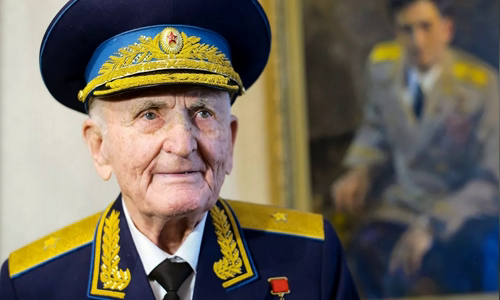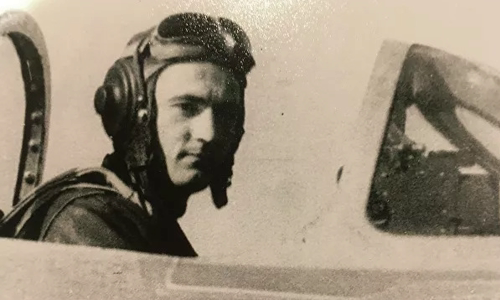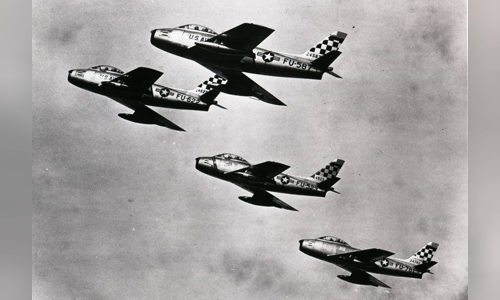General Sergei Kramarenko, the pilot awarded the Soviet Hero, revealed secret air battles between the Soviet Union and the United States on the Korean peninsula.
Air Force Brigadier General Sergei Kramarenko on February 16 revealed unprecedented information about the fierce battles between the Soviet and American air force during the Korean War. He is an experienced pilot who participated in World War II, was awarded the title of Hero of the Soviet Union and Ace class thanks to the achievement of shooting down 21 enemy aircraft during the Korean War (1950-1953).

General Kramarenko in 2019 Photo: Ria Novosti
General Kramarenko used to control LaGG-3 and La-5 fighters during World War II, shot down 3 Nazi planes directly and assisted his teammates to destroy 13 others. "The Soviet tactical and tactical skills overtook Germany at the end of the war. The practical experience helped us effectively deal with Americans," General Kramarenko said.
When the Korean War broke out in 1950, the Soviet Union and the United States, two allies in the war against fascism, became rivals on two fronts. In addition to sending infantry to join the UN forces against the Korean army, the US deployed F-80, F-84 aircraft and the most modern F-86 Saber fighter jet, the fighter line has just been compiled. invented in 1949, to occupy the skies on the Korean Peninsula.
In response, the Soviet Union deployed modern MiG-15 fighters to North Korea in November 1950. Soviet pilots took part in training North Korean and Chinese pilots and directly engaged in dogfights with American fighters.
Kramarenko said that American pilots have many points inferior to the Germans. They often avoided dogfights, while German pilots were always ready to rush in to confront Soviet aircraft. "In North Korea, we prove that Soviet pilots were not inferior to rivals in terms of skills, even surpassing the United States in terms of fighter capabilities," the air force said.
F-86 Saber can reach speeds above 1,100km / h, with the ability to glide and dive better MiG-15. They are also more balanced than the opponent in terms of aerodynamics. The US aircraft is also equipped with AN / APG-30 radar, which helps pilots take the line of sight and fire 6 more 12.7 mm caliber machine guns.
The MiG-15 has a lower maximum speed, only about 1,070 km / h, but possesses acceleration, climbing and maneuverability far beyond the F-86. The weapons on Soviet fighters were inferior in terms of accuracy, but overwhelming in power with two 23 mm guns and one 37 mm cannon.
The Soviet Air Force began fighting over the skies of Korea in the spring of 1951, during which Kramarenko made his first sortie on 1 April.
"That day, we took off urgently to intercept an escort fighter muscle. After reaching an altitude of 7,000 m along the Yalu River, we spotted the enemy. An American engine reconnaissance was given 8 injections escort escort, while we have 4 MiG-15s. I ordered an attack, "he recounted.
The arrival of the Soviet MiG-15 squadron led American reconnaissance to abandon the mission and return to the base, while the F-86s welcomed the war. Kramarenko shot down a Saber and wounded another plane, while the US side failed to take down any Soviet aircraft.

Kramarenko in the cockpit of a MiG-15 in 1951 Photo: Sputnik
General Kramarenko was also involved in the battle on 12 April 1951, an event that would later be called a "Dark Thursday" by US pilots. In that air combat, 30 Soviet MiG-15 fighters attacked the US air force squad of 48 B-29 strategic bombers escorted by 100 F-80 Shooting Star and F-84 Thunderjet fighters.
The US side acknowledged that 10 B-29s were shot down or severely damaged without causing damage to Soviet forces. The battle was so shocking that the US military stopped all bombing operations on the Korean Peninsula for three months and then ended the day air raids completely.
"I still vividly remember the picture of the battle, a whole fleet of aircrafts maintained a beautiful fighting formation like a parade. We abruptly swooped down from above them. I fired at a mechanical bombardment and fired. breached its fuel chamber, causing white smoke to emit. Then my teammates began to attack. It can be said that we inflicted pain on Americans, "General Kramarenko recounted the battle of" pinching. " US aircraft.
Kramarenko has many times confronted with Ace-class American pilots, a title for military pilots taking 5 or more enemy aircraft. One of his most memorable battles was the air battle with Glenn Eagleston, commander of the 334th U.S. Air Force Squadron and also a seasoned veteran who shot down 18 Nazi aircraft during World War II.
"Eagleston leads the border with three Sabers. Pilots 2 and 3 cover as he dives to attack the target. Eagleston misses, lowers and appears about 100 meters away from me. I immediately tilted. left and dived, then he opened fire again at me, "said General Kramarenko.
The two sides discussed for several minutes, before Kramarenko took an advantageous position and fired the shell on the F-86, causing it to be severely damaged. Eagleston lowered the altitude and escaped the battle, two pilots supporting Kramarenko's MiG-15. The Soviet pilot flew towards a dam with a Korean anti-aircraft artillery and maintained a distance of 800 meters with the American aircraft behind.
"Suddenly, anti-aircraft artillery shells exploded in front of me. I thought 'I'd rather die for my troops' and rushed into that area. I was lucky to not have hit any bullets. The Sabers were stop chasing and turn around, "Kramarenko recalled.
Eagleston brought F-86 fighter back to Kimpo air base and landed on his stomach. He was seriously injured, was returned to the United States, and ended his fighting career. The Saber itself was too badly damaged and was disqualified shortly thereafter.
Kramarenko's fortune seemed to end on January 17, 1952. He fights with two F-86 fighters and does not detect another squadron above him. His MiG-15 was hit and lost control, forcing Kramarenko to release an emergency chair to parachute. However, it did not end there.

An American F-86 fighter squadron during the Korean War Photo: USAF
"Suddenly the American plane came over and shot at me. The long distance caused the bullets to miss and fly under my feet. He circled after about 400-500 m to fire again, but I was lucky. when falling through a cloud. American pilots lost track of me and walked away, "he said.
Kramarenko landed in a forest and was not seriously injured, only a bump in his neck from the impact upon landing. He collected his parachute and walked west, before discovering that a Korean was collecting firewood.
"He took a long fork when he saw me because he thought I was American. I had to shout 'Kim Il-sung ho, Stalin cough', 'cough' meaning 'good' in Korean. He let me sit on the trolley and take him back to the village, they gave me food and rest, a car took me to the base the next morning, which was my last battle in North Korea before returning. Soviet Union, "he recounted.
According to Kramarenko, it is not uncommon for US pilots to shoot skydivers. One of his teammates was killed and one was injured by an American fighter bullet after launching an emergency exit.
The NVA Airborne Regiment No. 176, a unit of Kramarenko, lost a total of 8 pilots and 12 aircraft during the war. They destroyed about 50 American bombers and unspecified number of enemy fighters. Kramarenko himself shot down 21 aircraft but only recorded achievements with 13 aircraft, because the rest fell into the sea and could not be determined.
He believed that the battles in the skies of North Korea prevented a total war between the Soviet Union and the United States.
"The Americans had planned to drop 300 nuclear bombs on the Soviet Union. We showed them that the B-29s should not be so sharp on their territory. The US abandoned the Soviet airstrike strategy after it. I disabled 25 bombers in one battle on April 12, 1951, "Kramarenko said.
General Kramarenko served as commander of the regiment and air division division, as well as advising foreign air forces. He was appointed deputy chief of the 23rd Air Force Group in February 1979, retired two years later, and undertook a farewell flight in 1982.
"Now I can't fly anymore and I'm jealous of young pilots. Fighters today are modern, well-equipped armaments. It would be great to fly through clouds. I always dreaming of the sky, "said General Kramarenko.
At the age of 97, Kramarenko was the last Ace-class pilot of the Soviet Union in the Korean War.



 JimmythatCarroll
JimmythatCarroll







